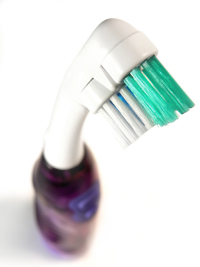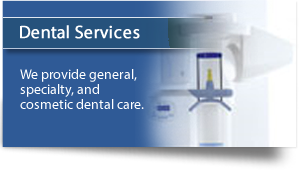Preventive Care
Why is oral hygiene so important?
Adults over 35 lose more teeth to gum diseases, (periodontal disease) than from cavities. Three out of four adults are affected at some time in their life. The best way to prevent cavities and periodontal disease is by good tooth brushing and flossing techniques, performed daily.
Periodontal disease and decay are both caused by bacterial plaque. Plaque is a colorless film, which sticks to your teeth at the gum line. Plaque constantly forms on your teeth. By thorough daily brushing and flossing you can remove these germs and help prevent periodontal disease.
Choosing Oral Hygiene Products
There are so many products on the market it can become confusing and choosing between all the products can be difficult. Here are some suggestions for choosing dental care products that will work for most patients. Seek products with the American Dental Association (ADA) seal of approval.
Fluoride toothpaste and mouth rinses if used in conjunction with brushing and flossing can reduce tooth decay as much as 40%. Remember, these rinses are not recommended for children under six years of age.
Anti-plaque rinses (Listerine), approved by the American Dental Association, contain agents that may help bring early gum disease under control. Use these in conjunction with brushing and flossing.
Brushing
While brushing the outside surfaces of your teeth, position the brush at a 45-degree angle where your gums and teeth meet. Gently move the brush in a circular motion several times using small, gentle strokes. Use light pressure while putting the bristles between the teeth, but not so much pressure that you feel any discomfort. Focus on two teeth at a time, and then move on spending at least two minutes a session. When you are done cleaning the outside surfaces of all your teeth, follow the same directions while cleaning the inside of the back teeth.
To clean the inside surfaces of the upper and lower front teeth, hold the brush vertically. Make several gentle back-and-forth strokes over each tooth. Don’t forget to gently brush the surrounding gum tissue.
Next you will clean the biting surfaces of your teeth by using short, gentle strokes. Change the position of the brush as often as necessary to reach and clean all surfaces. Try to watch yourself in the mirror to make sure you clean each surface. After you are done, rinse vigorously to remove any plaque you might have loosened while brushing.
If you have any pain while brushing or have any questions about how to brush properly, please be sure to ask your dentist or hygienist.
Professional Cleaning
Daily brushing and flossing will keep dental calculus to a minimum, but a professional cleaning will remove calculus in places your toothbrush and floss have missed. Your visit to our office is an important part of your program to prevent gum disease and to maintain good dental health.
Sealants
Highly effective in preventing decay on the biting surfaces of your chewing teeth, sealants are a simple procedure in which a tooth-colored acrylic “coating” is painted onto the surface of the tooth. This effectively “seals” the deep grooves acting as a barrier, protecting enamel from plaque and acids. Sealants protect the depressions and grooves of your teeth from food particles and plaque that brushing and flossing can’t reach.
Easy to apply, sealants take only a few minutes to treat each tooth. Sealants hold up well under the force of normal chewing and can last several years before a reapplication is needed. Children and adults can benefit from sealants in the fight against tooth decay. Sealants are typically covered by insurance for children, but not for adults.
Disclosing Tablets
Disclosing tablets are made of a harmless vegetable dye that stains plaque bright red. The main cause of cavities and periodontal disease is the accumulation of plaque. Plaque is the sticky film of food and bacteria that forms constantly on your teeth. Disclosing tablets can help you prevent cavities and periodontal disease by allowing you to see the plaque that hasn’t been removed. This assists you in removing the plaque before it hardens to become tartar.
After brushing and flossing, simply chew a disclosing tablet, swish it around your mouth, and rinse with water. Using a small dental mirror, check your teeth for any signs of red, especially near the gum line. Brush and floss these missed areas and you can be confident that your teeth are plaque-free.
When teaching your child how to brush their teeth or when checking to see if your child has brushed properly, the disclosing tablets are helpful. They reveal the areas that are missed when brushing. Your child’s brushing technique can improve significantly since he or she can “see” where the plaque is located.
Electric Toothbrush

Automatic and “high-tech” electronic toothbrushes are safe and effective for the majority of the patients. Oral irrigators (water spraying devices) will rinse your mouth thoroughly, but will not remove plaque. You need to brush and floss in conjunction with the irrigator. We see excellent results with electric toothbrushes called Sonicare and Interplak. Some toothbrushes have a rubber tip on the handle; this is used to massage the gums after brushing. There are also tiny brushes (interproximal toothbrushes) that clean between your teeth. Please discuss proper use and technique with your dentist or hygienist.
Flossing
Periodontal disease usually appears between the teeth where your toothbrush cannot reach. Flossing is a very effective way to remove plaque from those surfaces. However, it is important to floss with the proper technique. The following instructions will help you, but remember it takes time and practice.
Start with a piece of floss (“Glide” or waxed is easier) about 18″ long. Lightly wrap most of the floss around the middle finger of one hand and wrap the rest of the floss around the middle finger of the other hand. To clean the upper teeth, hold the floss tightly between the thumb and forefinger of each hand. Gently insert the floss between the teeth. Do not force the floss or try to snap it into place. Bring the floss to the gum line then curve it into a C-shape against one tooth. Slide it into the space between the gum and the tooth until you feel light resistance. Move the floss up and down on the side of one tooth. Remember there are two tooth surfaces that need to be cleaned in each space. Continue to floss each side of all the upper teeth. Be careful not to cut the gum tissue between the teeth. As the floss becomes soiled, turn from one finger to the other to get a fresh section.
To clean between the bottom teeth, guide the floss using the forefinger of both hands. Do not forget the backside of the last tooth on both sides, upper and lower. When you are done, rinse vigorously with water to remove plaque and food particles. Do not be alarmed if during the first week of flossing your gums bleed or are a little sore. If your gums hurt while flossing you could be doing it too hard or pinching the gum. As you floss daily, and remove the plaque, your gums will heal and the bleeding should stop.
Fluoride
The greatest breakthrough in preventive dentistry in the last fifty years has been the use of fluoride. Almost all water naturally contains some fluoride. About three-fourths of American cities add additional fluoride to the water supply for the prevention of tooth decay.
There are many benefits in the use of fluoride, for people of all ages. When children are young and their teeth are forming, fluoride joins with the enamel surface and makes it harder and more decay-resistant. The benefits for adults are just as great. Fluoride can help repair an early cavity, even before it becomes visible in the mouth, by rebuilding the enamel layer of the teeth.
Fluoride is also helpful in older adults to help solve the problem of root caries or root sensitivity. Fluoride rinses or gels are sometimes prescribed to help eliminate germs that cause gum disease. It is an important part of every tooth decay prevention program. When combined with the good hygiene habits of brushing and flossing, the number of cavities in children and adults can be dramatically reduced.
Nutrition & Health

Good nutrition plays a large role in your dental health. Brushing and flossing help to keep your teeth and gums healthy and strong; however, a balanced diet will help to boost your body’s immune system, leaving you less vulnerable to oral disease.
How often and what you eat have been found to affect your dental health. Starchy foods such as crackers, breads, cookies and candies cause the bacteria in your mouth to feed on it, the bacteria then produces acids, which attack your teeth for up to 20 minutes or more. Also foods that stick to your teeth or are slow to dissolve give the acids more time to work on destroying your tooth enamel.
Starchy foods:
- crackers
- breads
- cookies
- candies
Sticky/slow to dissolve foods:
- raisins
- granola bars
- chewy fruit snacks
- dried fruits
- potato chips
- hard candies
You may also want to avoid drinking soda, as it is high in acids and sugar. Saliva production increases at mealtime, rinsing away food particles and neutralizing harmful acids. Foods such as nuts, cheese, onions, and some teas have been shown to slow growth of decay-causing bacteria in the mouth.
Periodontal Involvement
Superfloss
You must learn how to brush and floss your bridge, braces, teeth and surrounding gums thoroughly every time you eat. At first, it is difficult to keep your gum and teeth under the bridge or around the braces plaque-free. Superfloss can dramatically help your homecare routine. Superfloss is a special kind of dental floss that comes in two sections. One segment is thin and stiff, which allows you to thread it through tight areas. The other segment is fuzzy, which facilitates the removal of dental plaque. First you need to thread the stiff segment of the superfloss under your bridge or dental braces, then pull the floss to the fuzzy segment, and then floss your teeth like you would normally.

